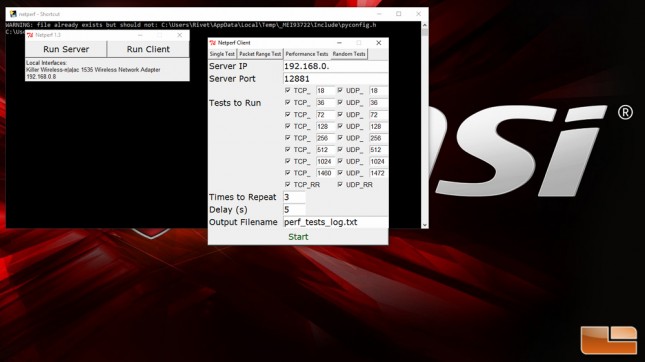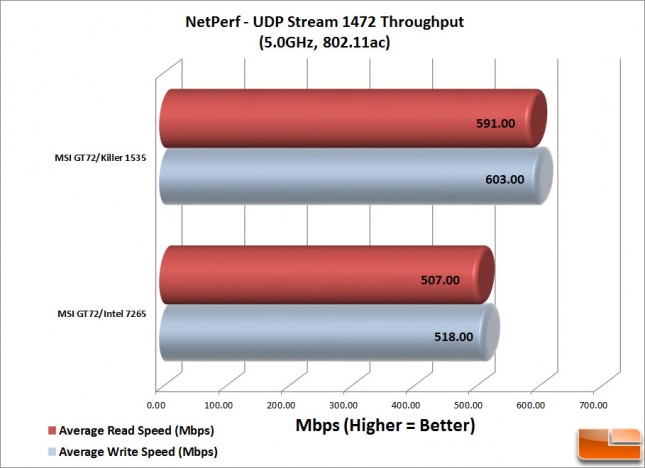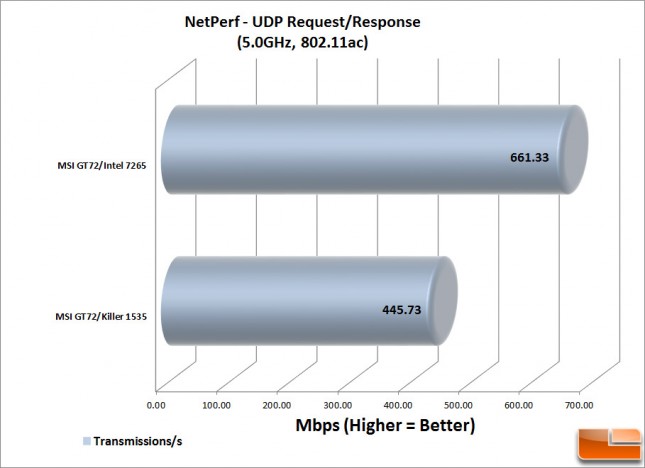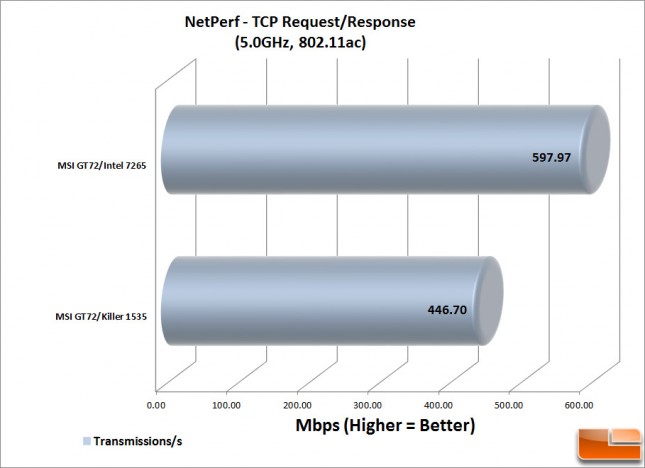Rivet Networks Killer Wireless-AC 1535 MU-MIMO Card Review
NETPERF Speed Test
Netperf is a lightweight benchmarking tool that can be used to measure the performance of a variety of different networking technology. Netperf includes tests that can evaluate unidirectional throughput between a client and server, and latency between endpoints. As such, it a useful tool for testing the performance of network controllers, like Killer Wireless or Killer Ethernet.
Netperf works by sending packing of data from its server module, to the client module, and measuring the throughput. The server and clients must be run from both endpoints, i.e. the client and server machines, to measure throughput in both directions. Measuring throughput in both directions is somewhat akin to measuring download and upload speeds.
- TCP (Transmission Control Protocol): TCP is one of the main protocols in TCP/IP networks. Whereas the IP protocol deals only with packets, TCP enables two hosts to establish a connection and exchange streams of data. TCP guarantees delivery of data and also guarantees that packets will be delivered in the same order in which they were sent. TCP provides reliable, ordered, and error-checked delivery of a stream of octets between applications running on hosts communicating over an IP network. TCP is the protocol that major Internet applications such as the World Wide Web, email, remote administration and file transfer rely on. Applications that do not require reliable data stream service may use the User Datagram Protocol (UDP), which provides a connectionless datagram service that emphasizes reduced latency over reliability.
- UDP (User Datagram Protocol): UDP is a transport layer protocol defined for use with the IP network layer protocol. With UDP, computer applications can send messages, in this case referred to as datagrams, to other hosts on an Internet Protocol (IP) network without prior communications to set up special transmission channels or data paths. UDP is suitable for purposes where error checking and correction is either not necessary or is performed in the application, avoiding the overhead of such processing at the network interface level.
Benchmark Results: UDP (User Datagram Protocol) is an alternative communications protocol used primarily for establishing low-latency and loss tolerating connections between applications on the Internet. Looking at our results, we see the Killer 1535 clearly has an advantage over the Intel 7265 wireless chipset in the amount of data being transmitted. Those who are interested in gaming should find this result very enlightening since this is a very good measure of how each chipset will do with gaming titles.
Benchmark Results: Netperf TCP_RR and UDP_RR (Request/Response) testing is a latency based test, which sends 1 byte packets in a round robin manner. To be more precise, a 1 byte packet is sent from one machine to another, and then a 1 byte packet is sent back. The number of transactions measured is an indication of Latency. Our benchmark results show the Intel 7265 chipset running ahead of the Killer 1535 in transmissions per second. Generally, the higher the number, the better as this test gives a very good indication how the network cards will work while gaming.
Benchmark Results: The Netperf TCP_RR test can be thought-of as a user-space to user-space ping with no think time – it is by default a synchronous, one transaction at a time, request/response test. The Intel 7265 chip does better in this particular test than the Killer 1535, but it is interesting the speeds of transmission both of these devices produce which is well above some of the other chipsets that we tested in our Legit Bunker. The Killer 1535 is still a solid performer when looking at TCP traffic.
Taking a look at the overall Netperf results, we see that the first thing it does is validate our LAN Speed Test results in that the Killer 1535-equipped MSI GT72 is significantly faster than that of the Intel 7265-equipped GT72. It didnt really matter what size packets or test suites we ran, the Rivet/Killer 1535 outperformed the Intel network card. The Killer 1535 does treat packets differently based on their WMM bit in the packet header. When the WMM is set to ‘Expedited’ (equaling Priority 1 applications as set in the Killer App), then the Killer 1535 module sends these particular packet out with higher priority, resulting in a lower latency. Killer automatically detects latency sensitive applications (ie VOIP, gaming, etc.) and sets the bits properly.




